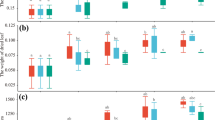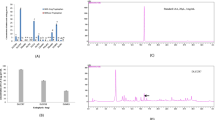Abstract
Background and aims
Tetrastigma hemsleyanum is a rare medicinal plant in China. Because it requires very strict environmental conditions to grow, it usually takes 3–5 years to form calabash-shaped roots and is difficult to meet the demand of Chinese medical market. Although it is known that endophytes can enhance the growth of the host plants, the molecular mechanism of the interplay between endophytes and their host plants growth is not completely understood yet. The aim of this study was to determine if endophytes can reduce the growth cycle and promote the medicinal ingredients in Tetrastigma hemsleyanum, and elucidate its underlying molecular mechanism.
Methods
Endophytic fungi were isolated and identified from the calabash-shaped root of Tetrastigma hemsleyanum. The fermentation broth of 6 endophyte strains (named as TH09, TH12, TH14, TH15, TH17 and TH26) were added to the MS medium to culture axenic plantlets. After 30 days of culture, the net growth, expansin gene expression and the flavonoid content were measured.
Results
From the calabash-shaped roots, we isolated 31 endophytic fungi belonging to 10 genera: Fusarium, Rhizopycnis, Colletotrichum, Cylindrocarpon, Emericellopsi, Penicillium, Plectosphaerella, Aspergillus tubingensis, Alternaria and Sarocladium, of which Fusarium is the dominant genus. Addition of the fermentation broth from strains TH12, TH15 and TH26 significantly increased the plant growth. Strains TH15 and TH26’s fermentation broth increased the expression of Th-exp (an expansin gene), while addition of the fermentation broth from TH14 increased Th-exp expression in leaves and stems, but decreased Th-exp expression in the root. Flavonoid content was increased in the presence of fermentation broth from strains TH09, TH14, TH17 and TH26. Particularly, the fermentation broth from TH26 can promote plant growth, enhance Th-exp expression and increase the flavonoid content in Tetrastigma hemsleyanum.
Conclusions
The results demonstrated that endophytic fungi from the calabash-shaped root of Tetrastigma hemsleyanum can regulate plant growth, expression of expansin gene and flavonoid content.




Similar content being viewed by others
References
Chen J, Zhang LC, Xing YM, Wang YQ, Xing XK, Zhang DW, Liang HQ, Guo SX (2013) Diversity and taxonomy of endophytic xylariaceous fungi from medicinal plants of Dendrobium (Orchidaceae). PLoS One 8:e58268
Cho HT, Cosgrove DJ (2000) Altered expression of expansin modulates leaf growth and pedicel abscission in Arabidopsis thaliana. Proc Natl Acad Sci U S A 97:9783–9788
Clay K (1987) Effects of fungal endophytes on the seed and seedling biology of Lolium perenne and Festuca arundinacea. Oecologia 73:358–362
Clay K, Holah J (1999) Fungal endophyte symbiosis and plant diversity in successional fields. Science 285:1742–1745
Compant S, Saikkonen K, Mitter B, Campisano A, Mercado-Blanco J (2016) Editorial special issue: soil, plants and endophytes. Plant Soil 405:1–11
Cosgrove DJ (2015) Plant expansins: diversity and interactions with plant cell walls. Curr Opin Plant Biol 25:162–172
Cosgrove DJ, Li LC, Cho HT, Hoffmann-Benning S, Moore RC, Blecker D (2002) The growing world of expansins. Plant Cell Physiol 43:1436–1444
Dai FL (1987) Fungal morphology and classification. Beijing: Science Press (in Chinese)
Du S, Xiang T, Song Y, Huang L, Sun Y, Han Y (2015) Transgenic hairy roots of Tetrastigma hemsleyanum: induction, propagation, genetic characteristics and medicinal components. Plant Cell Tissue Organ Cult 122:373–382
Fan SM, Huang ZH, Lin J, Huang XC, Xu YF, Xu W (2014) Separation and quantitative determination of four flavonoids in Tetrastigma hemsleyanum. Zhong Yao Cai 37:2226–2230 (in Chinese)
Frohlich J, Hyde KD (1999) Biodiversity of palm fungi in the tropics: are global fungal diversity estimates realistic? Biodivers Conserv 8:997–1004
Gangadevi V, Muthumary J (2009) A novel endophytic Taxol-producing fungus Chaetomella raphigera isolated from a medicinal plant, Terminalia arjuna. Appl Biochem Biotechnol 158:675–684
Garyali S, Kumar A, Reddy MS (2013) Taxol production by an endophytic fungus, Fusarium redolens, isolated from Himalayan yew. J Microbiol Biotechnol 23:1372–1380
Goh HH, Sloan J, Dorca-Fornell C, Fleming A (2012) Inducible repression of multiple expansin genes leads to growth suppression during leaf development. Plant Physiol 159:1759–1770
Gonzaga LL, Costa LE, Santos TT, Araújo EF, Queiroz MV (2015) Endophytic fungi from the genus Colletotrichum are abundant in the Phaseolus vulgaris and have high genetic diversity. J Appl Microbiol 118:485–496
Guo SX, Wang QY (2001) Character and action of good strain on stimulating seed germination of Gastrodia elata. Mycosystema 3:408–412
Hardoim PR, van Overbeek LS, Berg G, Pirttilä AM, Compant S, Campisano A, Döring M, Sessitsch A (2015) The hidden world within plants: ecological and evolutionary considerations for defining functioning of microbial endophytes. Microbiol Mol Biol Rev 79:293–320
Hartley SE, Gange AC (2009) Impacts of plant symbiotic fungion insect herbivores: mutualism in a multitrophic context. Annu Rev Entomol 54:323–342
Huang L, Song Y, Xiang T, Sun Y, Wu P, Wang B (2015) Cloning and analysis of two actin gene fragments from Tetrastigma hemsleyanum Diels et Gilg. J Hangzhou Normal University (Natural Science edition) 14:51–55 (in Chinese)
Jia M, Chen L, Xin HL, Zheng CJ, Rahman K, Han T, Qin LP (2016) A friendly relationship between endophytic fungi and medicinal plants: a systematic review. Front Microbiol 7:906
Khan A, Hossain MT, Park HC, Yun D, Shim SH, Chung YR (2016) Development of root system architecture of Arabidopsis thaliana in response to colonization by Martelella endophytica YC6887 depends on auxin signaling. Plant Soil 405:81–96
Lin Z, Chen L, Qiu Q, Guo S (2016) Isolation and identification of antiproliferative compounds from the roots of Tetrastigma hemsleyanum against MDA-MB-435S cell lines. Pak J Pharm Sci 29:1171–1175
Malinowaki DP, Beleaky DP (2000) Adaptations of endophyte-infected cool-season grass to environmental stresses: mechanisms of drought and mineral stress tolerance. Crop Sci 40:923–940
Marowa P, Ding A, Kong Y (2016) Expansins: roles in plant growth and potential applications in crop improvement. Plant Cell Rep 35:949–965
Mousa WK, Shearer CR, Limay-Rios V, Zhou T, Raizada MN (2015) Bacterial endophytes from wild maize suppress Fusarium graminearum in modern maize and inhibit mycotoxin accumulation. Front Plant Sci 6:805
Muangthong A, Youpensuk S, Rerkasem B (2015) Isolation and characterisation of endophytic nitrogen fixing bacteria in sugarcane. Trop Life Sci Res 26:41–51
Murashige T, Skoog F (1962) A revised medium for rapid growth and bio assays with tobacco tissue culture. Physiol Plant 18:100–127
Negreiros de Carvalho PL, Silva Ede O, Chagas-Paula DA, Hortolan Luiz JH, Ikegaki M (2016) Importance and implications of the production of phenolic secondary metabolites by endophytic fungi: a mini-review. Mini Rev Med Chem 16:259–271
Peng X, Zhuang DD, Guo QS (2015) Induction of S phase arrest and apoptosis by ethyl acetate extract from Tetrastigma hemsleyanum in human hepatoma HepG2 cells. Tumour Biol 36:2541–2550
Peng X, Zhang YY, Wang J, Ji Q (2016) Ethylacetate extract from Tetrastigma hemsleyanum induces apoptosis via the mitochondrial caspase-dependent intrinsic pathway in HepG2 cells. Tumour Biol 37:865–876
Qian L, Dai D, Jiang H, Lin W (2015) Research progresses of the endangered medicinal plant Tetrastigma hemsleyanum Diels et Gilg. Acta Agriculturae Zhejiangensis 27:1301–1308 (in Chinese)
Romão-Dumaresq AS, Dourado MN, Fávaro LC, Mendes R, Ferreira A, Araújo WL (2016) Diversity of cultivated fungi associated with conventional and transgenic sugarcane and the interaction between endophytic Trichoderma Virens and the host plant. PLoS One 11:e0158974
Saikkonen K, Young CA, Helander M, Schardl CL (2016) Endophytic Epichloë species and their grass hosts: from evolution to applications. Plant Mol Biol 90:665–675
Sampedro J, Cosgrove DJ (2005) The expansin superfamily. Genome Biol 6:242
Schmittgen TD, Livak KJ (2008) Analyzing real-time PCR data by the comparative C(T) method. Nat Protoc 3:1101–1108
Schoch CL, Seifert KA, Huhndorf S, Robert V, Spouge JL, Levesque CA, Chen W, Fungal Barcoding Consortium (2012) Nuclear ribosomal internal transcribed spacer (ITS) region as a universal DNA barcode marker for fungi. Proc Natl Acad Sci U S A 109:6241–6246
Sherameti I, Shahollari B, Venus Y, Altschmied L, Varma A, Oelmüller R (2005) The endophytic fungus Piriformospora indica stimulates the expression of nitrate reductase and the starch-degrading enzyme glucan-water dikinase in tobacco and Arabidopsis roots through a homeodomain transcription factor that binds to a conserved motif in their promoters. J Biol Chem 280:26241–262417
Song Y, Xiang T, Wu P, Wang B, Li J, Zhang T (2016) Molecular cloning, bioinformatics characterization and gene expression analysis of the full-length expansin gene cDNA from Tetrastigma hemsleyanum. Chin Tradit Herb Drugs 47:810–815 (in Chinese)
Stierle AA, Stierle DB (2015) Bioactive secondary metabolites produced by the fungal endophytes of conifers. Nat Prod Commun 10:1671–1682
Stierle A, Strobel G, Stierle D (1993) Taxol and taxane production by Taxomyces andreanae, an endophytic fungus of Pacific yew. Science 260:214–216
Sun Y, Li H, Hu J, Li J, Fan YW, Liu XR, Deng ZY (2013) Qualitative and quantitative analysis of phenolics in Tetrastigma hemsleyanum and their antioxidant and antiproliferative activities. J Agric Food Chem 61:10507–10515
Valente P, Gouveia FC, de Lemos GA, Pimentel D, van Elsas JD, Mendonça-Hagler LC, Hagler AN (1996) PCR amplification of the rDNA internal transcribed spacer region for differentiation of Saccharomyces cultures. FEMS Microbiol Lett 137:253–256
Wu LQ, Lv YL, Meng ZX, Chen J, Guo SX (2010) The promoting role of an isolate of dark-septate fungus on its host plant Saussurea involucrata Kar. Et Kir. Mycorrhiza 20:127–135
Xiong Y, Wu X, Rao L (2015) Tetrastigma hemsleyanum (Sanyeqing) root calabash-shaped root extracts induces apoptosis in human cervical carcinoma HeLa cells. J Ethnopharmacol 65:46–53
Xu CJ, Ding GQ, Fu JY, Meng J, Zhang RH, Lou XM (2008) Immunoregulatory effects of ethyl-acetate fraction of extracts from Tetrastigma hemsleyanum Diels et. Gilg on immune functions of ICR mice. Biomed Environ Sci 21:325–331
Zhang HW, Song YC, Tan RX (2006) Biology and chemistry of endophytes. Nat Prod Rep 23:753–771
Zhu MX, Yan LH (2014) Resource investigation on rare and endangered she medicine Tetrastigma hemsleyanum in Zhejiang Province. Zhong Yao Cai 37:766–770 (in Chinese)
Acknowledgments
The work was supported by grants from the National Key Research and Development Project of China (Grant No. 2016YFC0503100), the Project of Science and Technology of Zhejiang Province for Commissioner (T Xiang), the Hangzhou Science and Technology Development Plan (Grant No. 20140432B05) and the Projects of Zhejiang Provincial Key Laboratory for Genetic Improvement and Quality Control of Medicinal Plants (Grant No. 201302).
Author information
Authors and Affiliations
Corresponding author
Additional information
Responsible Editor: Katharina Pawlowski.
Electronic supplementary material
ESM 1
(DOCX 2107 kb)
Rights and permissions
About this article
Cite this article
Song, Y., Wu, P., Li, Y. et al. Effect of endophytic fungi on the host plant growth, expression of expansin gene and flavonoid content in Tetrastigma hemsleyanum Diels & Gilg ex Diels. Plant Soil 417, 393–402 (2017). https://doi.org/10.1007/s11104-017-3266-1
Received:
Accepted:
Published:
Issue Date:
DOI: https://doi.org/10.1007/s11104-017-3266-1




